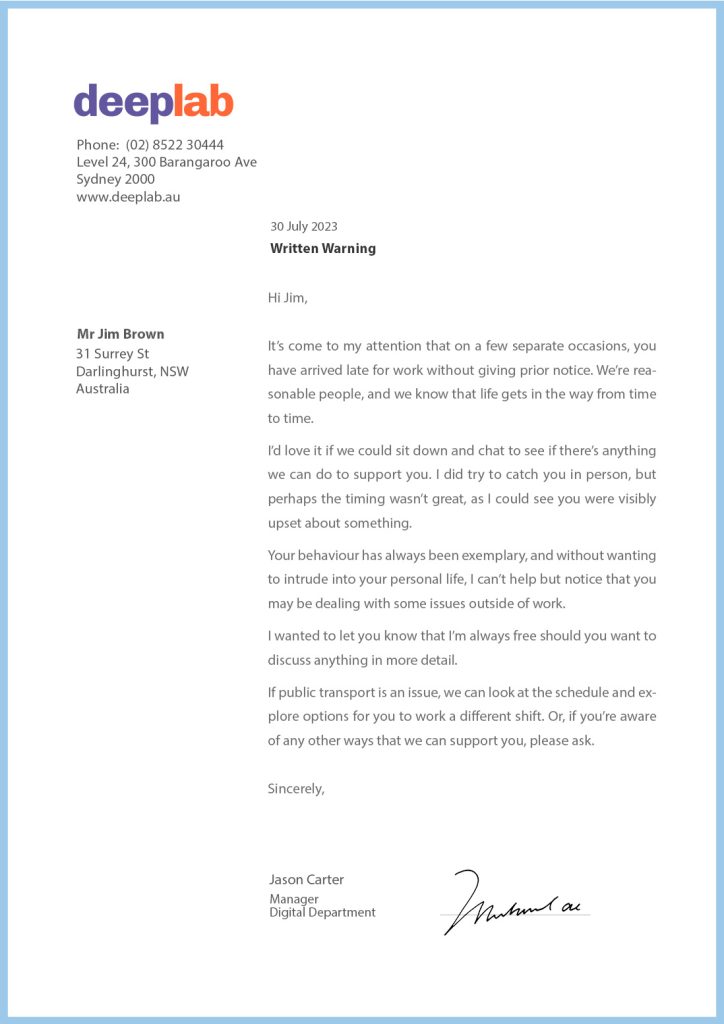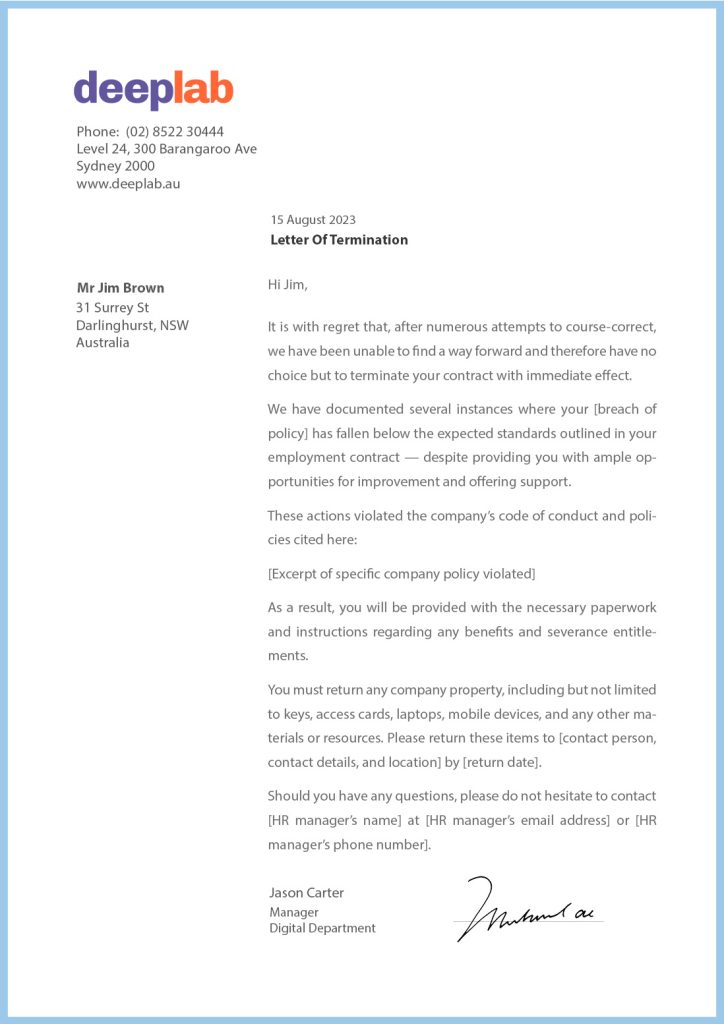Do you have an underperforming employee who won’t “take the hint”? Don’t avoid the issue. Managers who turn a blind eye to misconduct allow bad attitudes to fester and spread within their teams.
Performance issues rarely get better without your intervention. They almost always become worse, snowballing into irrecoverable messes and reflecting poorly on you as a leader.
Let me help you by providing templates for writing effective first, second and final warning letters to an underperforming employee.
(Related: What Is The Correct Formal Letter Format?)
When Can I Issue A Warning Letter To An Employee?
A warning letter is a formal notice that you use to document an incident and clarify future consequences. You can send it via email or send it via traditional mail.
You might consider sending one for two reasons.
| Behaviour correction | The employee is not meeting your expectations. You need a mechanism that corrects their behaviour. |
| Employee termination | A letter sits on an employee’s file. If performance doesn’t improve, you’ll have a record of disciplinary action (which leaves you less exposed to unfair dismissal claims) that helps you manage them out of the business. |
What Steps Must You Follow When Issuing A Warning Letter To An Employee?
Almost all workplaces have a progressive disciplinary policy that outlines a clear escalation of consequences for continued misbehaviour.
Before making any rash moves, check with your HR department to ensure you’re following the right steps.
Typically, a progressive disciplinary policy consists of the following steps:
Step 1: Give A Verbal Warning.
I’ve seen so many managers get this preliminary procedure wrong and use verbal warnings as an excuse to berate and even intimidate employees.
Just because a conversation is unrecorded doesn’t mean it won’t come back to bite you on the backside if you’ve overstepped the mark.
A verbal warning should:
- Take place as a casual conversation.
- Highlight the areas of concern.
- Facilitate discussion around ways to eradicate misconduct.
Expert Tip.
Use emotionally sensitive language such as “Help me understand where you’re coming from” and “Let’s work on this problem together” to avoid rubbing people up the wrong way. It’s a strategy endorsed by neuro-linguistic programming experts.
Step 2: Send A Warning Letter.
If the poor performance continues, escalate to a warning letter.
Either you (I’m assuming that you’re a hiring manager), someone in senior management, or HR needs to do it.
(Related: How To Improve Communication In The Workplace).
First Written Warning Letter [Template].
The first warning letter should always seek to understand rather than approach the situation like a bull in a china shop. In fact, it shouldn’t read like a warning at all.
It must have a warm and understanding tone (but not completely sympathetic).
By taking a professional and constructive approach, you can maintain a positive work environment while protecting your organisation’s interests.
Here’s a sample first warning letter:
Mr Jim Brown – 1st Warning Letter
Job Title: Web Developer
Supervisor: Hannah Doe
Human Resources Representative: Irene Smith
Date: May 13, 2023
Hi Jim,
It’s come to our attention that on a few separate occasions, you have arrived late for work without giving prior notice. We’re reasonable people, and we know that life gets in the way from time to time.
I’d love it if we could sit down and chat to see if there’s anything we can do to support you. I did try to catch you in person, but perhaps the timing wasn’t great, as I could see you were visibly upset about something.
Your behaviour has always been exemplary, and without wanting to intrude into your personal life, I can’t help but notice that you may be dealing with some issues outside of work.
I wanted to let you know that I’m always free should you want to discuss anything in more detail.
If public transport is an issue, we can look at the schedule and explore options for you to work a different shift. Or, if you’re aware of any other ways that we can support you, please ask.
Sincerely,
Jason H. Carter
Manager – Digital Department
Please sign and date below:
Employee signature in acknowledgment of warning:
Date:
This is what the warning letter might look like on your company letterhead:

Should You Have A Follow-Up Meeting?
Yes. After the employee has received the warning letter, you hold an informal meeting to understand the nature of the misconduct. (Do this for every subsequent warning letter you send).
A successful outcome is one in which:
- Both parties leave the room on good terms.
- The employee commits to adhering to company rules.
- Reasonable adjustments are made to accommodate the employee.
Sometimes, retaining an employee is as simple as moving their start time 15 minutes later due to family commitments or moving them to a different department to mitigate ongoing conflicts.
Important!
It’s best practice to meet with the employee a few days after the warning letter has been received to allow frustrations to subside.
Second Written Warning Letter [Template].
If the initial warning letter and meeting elicit no positive response, you will need to send a second letter.
Things are getting a little heated at this stage, so where possible, send in the HR cavalry or a senior team member to cool things.
Important!
Your HR team should send a warning letter that’s dispassionate and not emotive. After all, you have to work with this employee and don’t need any unnecessary tension.
(Use the same letterhead and signature used in the previous employee warning letter; do the same for every subsequent warning letter.)
Hi Jim,
This is your second written warning due to your poor punctuality. On April 13, 2023, your scheduled shift began at 9:30 AM, and you arrived late at 9:43 AM. Your line manager raised this and reminded you of the importance of being on time, but the issue seems to be ongoing.
Reasonable adjustments to shift patterns were made to accommodate your public transport schedules, but since then, you have been late on the following dates:
- April 19, 2023: Shift began at 9:30; arrived at 10:05.
- April 22, 2023: Shift began at 9:30; arrived at 9:52.
- April 23, 2023: Shift began at 9:30; arrived at 9:39.
As outlined in our Employee Handbook: ‘Employees arriving more than five minutes after their scheduled shift begins must inform their direct supervisor. Failure to do so on three separate occasions in a fiscal quarter will result in a written warning.’
If you are experiencing an ongoing issue that we can assist with, we encourage you to communicate that with your supervisor or privately with HR.
It is with regret that we have to remind you that we reserve the right to terminate your employment should you fail to meet your contractual obligations.
We hope that we can move forward positively and get back to our winning ways as soon as possible.
Here’s how this template may look on your company letterhead:

Final Written Warning Letter [Template].
Okay, so you’ve tried to be the good cop, and it’s not worked. Sometimes people will take liberties and push the boundaries.
Play stupid games, win stupid prizes… If an employee isn’t playing ball, that’s not on you.
When all else fails, it’s time for the final warning letter and termination of employment. In the final warning, remember to include:
- Details of the offences and the process which has been followed.
- Notification of termination of employment.
- Instructions for returning company property.
- Contact details for further support.
Important!
Some company policies include temporary suspension of duties for the employee rather than immediate termination. This will depend on the nature and seriousness of the violation.
Again, be dispassionate. This is all about damage limitation.
The last thing you need is an aggrieved ex-employee spreading vicious rumours, vandalising your property, posting baseless lies on social media, or leaving fake reviews.
Trust me, you’ve got more important things to be dealing with.
Hi Jim,
It is with regret that, after numerous attempts to course-correct, we have been unable to find a way forward and therefore have no choice but to terminate your contract with immediate effect.
We have documented several instances where your [breach of policy] has fallen below the expected standards outlined in your employment contract — despite providing you with ample opportunities for improvement and offering support.
These actions violated the company’s code of conduct and policies cited here:
[Excerpt of specific company policy violated]
As a result, you will be provided with the necessary paperwork and instructions regarding any benefits and severance entitlements.
You must return any company property, including but not limited to keys, access cards, laptops, mobile devices, and any other materials or resources. Please return these items to [contact person, contact details, and location] by [return date].
Should you have any questions, please do not hesitate to contact [HR manager’s name] at [HR manager’s email address] or [HR manager’s phone number].
We understand that this news may be difficult to receive, but it is important to maintain professionalism during this transition. Unfortunately, this decision is final and non-negotiable.
We wish you the best of luck in your future endeavours.
This is what the final warning and termination letter might look like on your company letterhead:

What Is The Correct Format Of A Warning Letter?
As with all pieces of professional documentation, there are standards you should follow when composing an employee warning letter.
Before we cover the main elements, be sure to format your warning letter correctly.
These are official records and should always include:
- The company letterhead.
- The employee’s current department and their direct supervisor’s name.
- The date on which the letter was sent.
- The signature of the sender.
1. Provide A Reason For The Warning.
Include a brief, one-line explicit statement on the nature of the warning letter.
Then, explicitly and factually recount the incident that led to the warning. Include the time and date, other parties involved, and accurate details about the misconduct.
Important!
Refrain from dramatising the events or using any emotional language, which can cause the situation to escalate.
2. Highlight Company Policies In Violation.
Include the exact language of the violated policy from the employee handbook.
This prevents employees from claiming they were unaware of the rule or that the employer targeted them for an arbitrary, personal reason.
Once the rule has been quoted, reinstate the expectation and how their actions violated it.
3. Outline Consequences.
Remind your employee of the progression of consequences. This section will differ depending on the number of violations on record and the severity of the circumstances. However, it could include:
- Actions required, such as a second warning letter.
- A forfeiture of rights, such as bonuses and flexible working.
- Disciplinary meetings and previous warnings.
- A documented roadmap of the employee’s performance.
- Temporary suspension.
- Termination.
Indicate any consequences the employee has already received.
4. Offer Solutions.
In many cases, minor incidents result from misunderstandings or uncertainty about approaching a problem.
Expert Tip.
By offering solutions, such as coaching, supervisor check-ins, and training, you can address violations in a way that empowers the employee to improve rather than feeling disheartened or ostracised.
5. End On A Positive Note.
Wrap up the letter with an optimistic sentiment, such as welcoming the employee to chat with you about any support they might need.
Important!
Remember that the goal is to improve employee performance, not set them up for failure. And the last thing you need is another misconduct headache.
Frequently Asked Questions About Written Warning Letters.
Managers are often unsure about these nuances.
Do I Need A Lawyer To Assist With Drafting A Formal Warning Letter?
In Australia, you don’t legally need to have a lawyer assisting with creating a formal warning letter.
However, it can be helpful to seek legal advice if:
- You are uncertain about the severity of the actions
- The situation is particularly complex
- Terminating the employer’s contract results in significant consequences like visa or living situation changes for the employee.
What Is The Downside Of Issuing A Warning Letter?
Sometimes, employees will lodge an unfair dismissal claim if they believe they have been treated unfairly during the warning process. They can lodge this complaint with the Fair Work Commission (FWC).
If an employee lodges a complaint, the FWC will review the following in line with National Employment Standards:
- The employer’s evidence of their actions and the decision-making process
- The number of previous warnings that the employer gave the underperforming employee
- The clarity of the instructions given to help the employee improve
- The amount of time given to the employee for improvement before dismissal.
Important!
A formal written warning letter does not automatically protect an employer in an unfair dismissal claim. See the Small Business Fair Dismissal Code to understand termination requirements.
What Offences Warrant An Employee Warning Letter?
This depends on the seriousness of the misconduct. For minor offences, you must ensure you’ve given plenty of verbal warnings to the employee and given them reasonable time to adjust their behaviour.
Your business’s employee handbook will categorise specific expectations around behaviour, along with particular offences and their severity.
Minor offences:
- Repeatedly late for work.
- Underperforming in daily duties.
- Workplace disputes with other colleagues.
- Dress code violations.
- Using profane language.
Major offences:
- A breach of workplace health and safety policies.
- Theft from a colleague or the workplace.
- Making threats to other staff members or customers.
- Sexually inappropriate behaviour.
- A pattern of missed deadlines, calls, or meetings.
Final Words On Writing A Warning Letter To An Employee
If you want lasting harmony within your team, there are no two ways about it: you’ll need to master the art of writing a warning letter at some stage in your leadership career.
It’s a necessary evil for those responsible for keeping teams motivated. Ignore at your own peril.
Tommy







Saranne Segal says:
Great article on handling workplace conflict! One factor I think should deepen the discussion further is the role of cultural differences within workplace conflicts. Many times what seems like a value conflict may actually turn out to be a cultural misunderstanding, especially in very diverse teams. Acknowledging and respecting these cultural nuances can really mean the difference between resolution and disputes and establishing an inclusive environment.
Additionally, it may help to mention the value of psychological safety. When employees feel they can speak up without repercussion, that alone can end low-level conflicts and foster more open channels of communication. This, of course, fits right in with your notes of how respect and empathy are key parts of conflict management. Thanks for illuminating an important topic and sharing your insight.
Steven McConnell says:
Thanks Saranne, you make valid points.